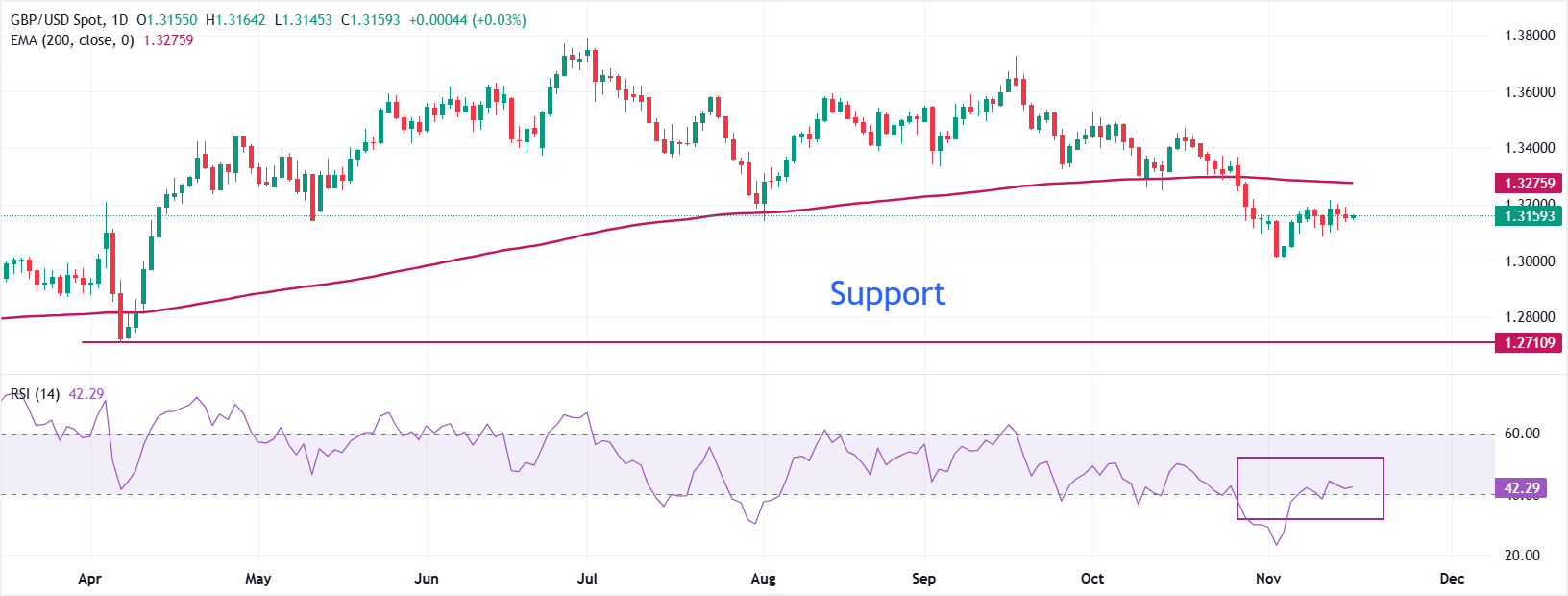
- The Pound Sterling faces mild selling pressure against its major peers ahead of the UK inflation data to be released on Wednesday.
- UK inflation is expected to have fallen slightly in October.
- Traders trim Fed dovish bets as officials warn of upside inflation risks.
The Pound Sterling (GBP) trades subdued against its major currency peers on Tuesday as investors turn cautious ahead of the United Kingdom (UK) Consumer Price Index (CPI) data for October, which will be released on Wednesday.
Investors will pay close attention to the UK inflation data to get cues about whether the Bank of England (BoE) will resume its monetary-easing campaign in the December policy meeting.
The CPI report is expected to show that headline inflation fell to 3.6% year-on-year from 3.8% in September. In the same period, the core CPI – which excludes volatile items such as food, energy, alcohol, and tobacco – is expected to have decelerated to 3.4% from the prior reading of 3.5%. On a monthly basis, the headline inflation is seen up 0.4% after remaining flat in September.
Signs of cooling price pressures would prompt bets supporting an interest rate cut by the BoE in the December meeting. On the contrary, sticky figures are unlikely to act as a major drag on BoE dovish speculation due to weak job market conditions and cooling Gross Domestic Product (GDP) growth. Last week, the labour market data for September showed that the Unemployment Rate jumped to 5%.
Later this week, investors will also focus on the UK Retail Sales data for October and the preliminary S&P Global Purchasing Managers’ Index (PMI) data for November, which will be released on Friday.
Pound Sterling Price Today
The table below shows the percentage change of British Pound (GBP) against listed major currencies today. British Pound was the weakest against the New Zealand Dollar.
| USD | EUR | GBP | JPY | CAD | AUD | NZD | CHF | |
|---|---|---|---|---|---|---|---|---|
| USD | 0.05% | 0.06% | 0.09% | -0.11% | -0.08% | -0.12% | 0.08% | |
| EUR | -0.05% | 0.01% | 0.05% | -0.15% | -0.13% | -0.16% | 0.02% | |
| GBP | -0.06% | -0.01% | 0.02% | -0.16% | -0.16% | -0.17% | 0.00% | |
| JPY | -0.09% | -0.05% | -0.02% | -0.19% | -0.17% | -0.22% | -0.02% | |
| CAD | 0.11% | 0.15% | 0.16% | 0.19% | 0.02% | -0.01% | 0.17% | |
| AUD | 0.08% | 0.13% | 0.16% | 0.17% | -0.02% | -0.03% | 0.21% | |
| NZD | 0.12% | 0.16% | 0.17% | 0.22% | 0.01% | 0.03% | 0.18% | |
| CHF | -0.08% | -0.02% | -0.01% | 0.02% | -0.17% | -0.21% | -0.18% |
The heat map shows percentage changes of major currencies against each other. The base currency is picked from the left column, while the quote currency is picked from the top row. For example, if you pick the British Pound from the left column and move along the horizontal line to the US Dollar, the percentage change displayed in the box will represent GBP (base)/USD (quote).
Daily digest market movers: Pound Sterling ticks down against US Dollar
- The Pound Sterling edges lower to near 1.3145 against the US Dollar (USD) during the European trading session on Tuesday. The GBP/USD pair is expected to remain sideways as investors await the United States (US) Nonfarm Payrolls (NFP) data for September, which is scheduled for release on Thursday.
- At the press time, the US Dollar Index (DXY), which tracks the Greenback’s value against six major currencies, trades marginally higher to near 99.60.
- The impact of the NFP data will be significant as major economic releases in over six weeks have remained halted due to the US government shutdown. Investors will monitor the employment data to get cues about the current labour market trend. August’s NFP report demonstrated a sharp slowdown in the hiring trend, which prompted market bets supporting more interest rate cuts by the Federal Reserve (Fed) this year.
- Since the US NFP data for August was released, the Fed has reduced interest rates two times by 50 basis points (bps) cumulatively to 3.75%-4.00%.
- Meanwhile, traders have trimmed Fed dovish expectations as officials have expressed caution about further interest rate cuts, citing upside inflation risks.
- "The current policy stance is still somewhat restrictive, but we have moved it closer to its neutral level that neither restricts nor stimulates the economy," Fed Vice Chair Philip Jefferson said at an event in Kansas City on Monday, Reuters reported. He warned that further interest rate cuts would likely “stop putting downward pressure on inflation”.
Technical Analysis: Pound Sterling stays below 200-day EMA

The Pound Sterling trades inside Monday’s trading range around 1.3160 against the US Dollar at the time of writing. The overall trend of the pair remains bearish as it trades below the 200-day Exponential Moving Average (EMA), which is around 1.3276.
The 14-day Relative Strength Index (RSI) strives to hold above 40.00. A fresh bearish momentum would emerge if the RSI falls back below that level.
Looking down, the April low near 1.2700 will act as a key support zone. On the upside, the October 28 high around 1.3370 will act as a key barrier.
Inflation FAQs
Inflation measures the rise in the price of a representative basket of goods and services. Headline inflation is usually expressed as a percentage change on a month-on-month (MoM) and year-on-year (YoY) basis. Core inflation excludes more volatile elements such as food and fuel which can fluctuate because of geopolitical and seasonal factors. Core inflation is the figure economists focus on and is the level targeted by central banks, which are mandated to keep inflation at a manageable level, usually around 2%.
The Consumer Price Index (CPI) measures the change in prices of a basket of goods and services over a period of time. It is usually expressed as a percentage change on a month-on-month (MoM) and year-on-year (YoY) basis. Core CPI is the figure targeted by central banks as it excludes volatile food and fuel inputs. When Core CPI rises above 2% it usually results in higher interest rates and vice versa when it falls below 2%. Since higher interest rates are positive for a currency, higher inflation usually results in a stronger currency. The opposite is true when inflation falls.
Although it may seem counter-intuitive, high inflation in a country pushes up the value of its currency and vice versa for lower inflation. This is because the central bank will normally raise interest rates to combat the higher inflation, which attract more global capital inflows from investors looking for a lucrative place to park their money.
Formerly, Gold was the asset investors turned to in times of high inflation because it preserved its value, and whilst investors will often still buy Gold for its safe-haven properties in times of extreme market turmoil, this is not the case most of the time. This is because when inflation is high, central banks will put up interest rates to combat it. Higher interest rates are negative for Gold because they increase the opportunity-cost of holding Gold vis-a-vis an interest-bearing asset or placing the money in a cash deposit account. On the flipside, lower inflation tends to be positive for Gold as it brings interest rates down, making the bright metal a more viable investment alternative.








